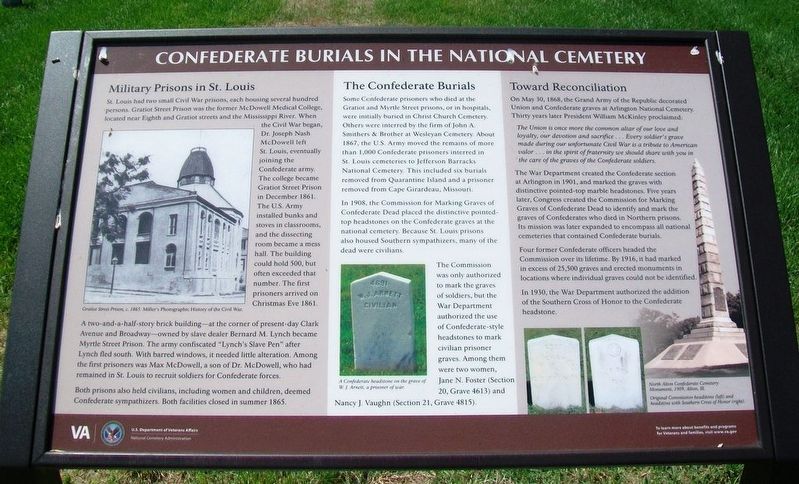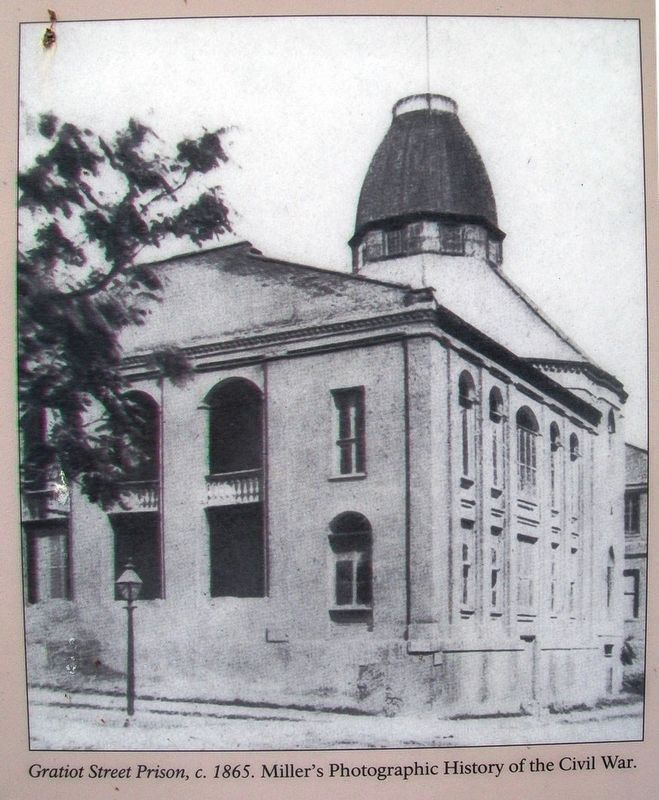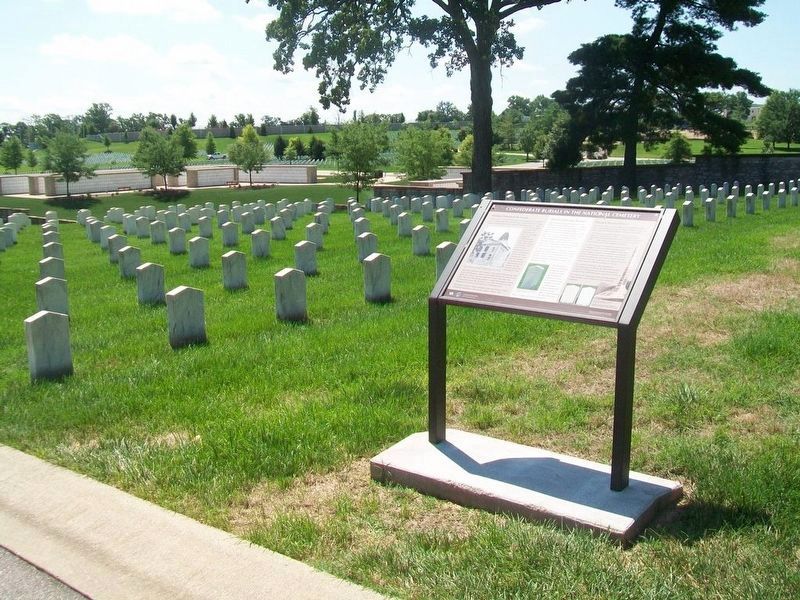Confederate Burials in the National Cemetery
Military Prison in St. Louis
St. Louis had two small Civil War prisons, each housing several hundred persons. Gratiot Street Prison was the former McDowell Medical College, located near Eighth and Gratiot streets and the Mississippi River. When the Civil War began, Dr. Joseph Nash McDowell left St. Louis, eventually joining the Confederate army. The college became Gratiot Street Prison in December 1861. The U.S. Army installed bunks and stoves in classrooms, and the dissecting room became a mess hall. The building could hold 500, but often exceeded that number. The first prisoners arrived on Christmas Eve 1861.
A two-and-a-half story brick building—at the corner of present-day Clark Avenue and Broadway—owned by slave dealer Bernard M. Lynch became Myrtle Street Prison. The army confiscated "Lynch's Slave Pen" after Lynch fled south. With barred windows, it needed little alteration. Among the first prisoners was Max McDowell, a son of Dr. McDowell, who had remained in St. Louis to recruit soldiers for Confederate forces.
Both prisons also held civilians, including women and children, deemed Confederate sympathizers. Both facilities closed in summer 1865.
The Confederate Burials
Some Confederate prisoners who died at the Gratiot and Myrtle Street prisons, or in hospitals, were initially
In 1908, the Commission for Marking Graves of Confederate Dead placed the distinctive pointed-top headstones on the Confederate graves at the national cemetery. Because St. Louis prisons also housed Southern sympathizers, many of the dead were civilians.
The Commission was only authorized to mark the graves of soldiers, but the War Department authorized the use of Confederate-style headstones to mark civilian prisoner graves. Among them were two women, Jane N. Foster (Section 20, Grave 4613) and Nancy J. Vaughn (Section 21, Grave 4815).
Toward Reconciliation
On May 30, 1868, the Grand Army of the Republic decorated Union and Confederate graves at Arlington National Cemetery. Thirty years later President William McKinley proclaimed:
The Union is once more the common altar of our love and loyalty, our devotion and sacrifice...Every soldier's grave made during our unfortunate Civil War is a tribute to American valor...in the spirit of fraternity we should share with you in the care of the graves of the Confederate soldiers.
The War Department created the Confederate section at Arlington in 1901, and marked the graves with distinctive pointed-top marble headstones. Five years later, Congress created the Commission for Marking Graves of Confederate Dead to identify and mark the graves of Confederates who died in Northern prisons. Its mission was later expanded to encompass all national cemeteries that contained Confederate burials.
Four former Confederate officers headed the Commission over its lifetime. By 1916, it had marked in excess of 25,500 graves and erected monuments in locations where individual graves could not be identified.
In 1930, the War Department authorized the addition of the Southern Cross of Honor to the Confederate headstone.
[Photo captions, from left, read]
Gratiot Street Prison, c. 1865. Miller's Photographic History of the Civil War.
A Confederate headstone on the grave of W.J. Arnett, a prisoner of war.
North Alton Confederate Cemetery Monument, 1909, Alton, Ill.
Original Commission headstone (left) and headstone with Southern Cross of Honor (right).
Erected by National Cemetery Administration.
Topics and series. This historical marker is listed in these topic lists: Cemeteries & Burial Sites
Location. 38° 29.871′ N, 90° 16.885′ W. Marker is near Lemay, Missouri, in St. Louis County. Marker is on South Drive, 0.1 miles west of Monument Drive, on the left when traveling west. Marker is in Section 19. Touch for map. Marker is at or near this postal address: 2900 Sheridan Road, Saint Louis MO 63125, United States of America. Touch for directions.
Other nearby markers. At least 8 other markers are within walking distance of this marker. To The Confederate Dead 1861 - 1865 (a few steps from this marker); In Memory of the Unknown Dead (about 400 feet away, measured in a direct line); Civil War Union Women Memorial (about 400 feet away); Civil War Memorial (about 500 feet away); Jefferson Barracks National Cemetery (about 500 feet away); Minnesota Civil War Memorial (about 500 feet away); 56th U.S. Colored Infantry Memorial (about 500 feet away); Indian Army (about 500 feet away). Touch for a list and map of all markers in Lemay.
Also see . . .
1. Gratiot Street Prison, St. Louis. Civil War St. Louis website entry (Submitted on July 29, 2016, by William Fischer, Jr. of Scranton, Pennsylvania.)
2. Military Prisons. The Civil War in Missouri website entry (Submitted on June 9, 2022, by Larry Gertner of New York, New York.)
3. Jefferson Barracks National Cemetery. Veterans Administration website entry (Submitted on July 29, 2016, by William Fischer, Jr. of Scranton, Pennsylvania.)
Credits. This page was last revised on August 22, 2023. It was originally submitted on July 29, 2016, by William Fischer, Jr. of Scranton, Pennsylvania. This page has been viewed 552 times since then and 21 times this year. Last updated on October 15, 2018, by Devry Becker Jones of Washington, District of Columbia. Photos: 1, 2, 3. submitted on July 29, 2016, by William Fischer, Jr. of Scranton, Pennsylvania. • Andrew Ruppenstein was the editor who published this page.


